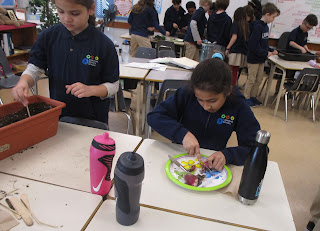Science Topics
Plant Growth and Changes
Students learn about the structure and growth of plants by raising plants in the classroom and by observing plant growth within the community. They learn to recognize and describe different forms of leaves, stems, roots and flowers and learn their functions in supporting the growth and reproduction of the plant. They learn various ways of starting new plants and the plants' requirements for growth. Through hands-on activities, students learn that different plants have different needs, and they gain skills and attitudes for their care.
Waste and our World
Students learn about wastes produced through natural processes and human technology. In studying natural systems, students learn that all plants, animals and other living things are made up of materials that are recycled through the environment again and again. In studying human consumption and wastes, students identify wastes produced within their community and learn the methods used for disposal. They learn that some waste materials are biodegradable, that some are reusable, and that others are toxic. They learn that personal action in reducing, reusing and recycling materials can help decrease the waste we accumulate.
Wheels and Levers
Students learn about basic components of simple machines: how they are assembled, how they operate, how they are used. Students explore different techniques that can be used to transfer motion from one component to another, using simple connectors and various levers, gears, pulleys and band driven systems. As they work with these components, they learn the functions that each can perform, including sample applications and ways that they can be used in a larger system. As part of their studies, they examine how these simple machines are used to change the speed or force of movement.
Building Devices & Vehicles that Move
Students apply simple techniques and tools in building devices and vehicles that move. In constructing these objects, students apply previous learnings about structures and explore new applications for wheels, rollers, gears, pulleys and a variety of levers and connectors. They learn that different forms of energy can be used to propel their model devices: in some cases, a direct push; in other cases, the stored energy from a compressed spring or falling weight. On completing their projects, students learn to evaluate their work, by describing the effectiveness of the device and the appropriateness of materials used.
Light and Shadows
Students learn about light by studying the effects of light on things within their environment. They learn about light sources, about materials that light can pass through and about what happens when a material blocks or changes the path of light. By observing shadows and their motions relative to a light source, students discover that light and shadows fall along a predictable path. They discover that mirrors, prisms and a variety of other materials can affect that path by reflecting and refracting light and by splitting light into colours.


Comments
Post a Comment